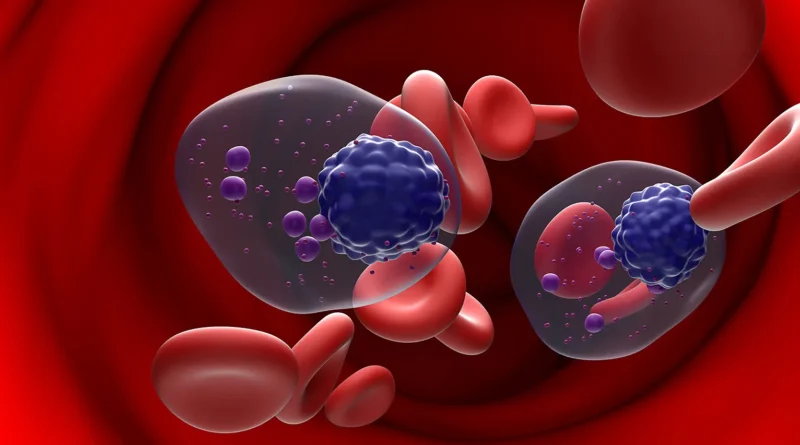For the First Time, Blocking PYCR1 in Stromal Cells Lowers a Protein That Fuels Myeloma
Speed-read
- PYCR1 is an enzyme found in multiple myeloma and stromal cells.
- Blocking PYCR1 reduces production of activin A, a protein that helps multiple myeloma cells grow and survive.
- This finding is reported for the first time.
- The approach has not yet been tested in humans.
Multiple myeloma is a type of cancer that affects plasma cells, specialized white blood cells found in the bone marrow—the soft tissue inside the bones where blood cells are produced. In multiple myeloma, plasma cells become abnormal, multiply excessively in the bone marrow, and produce abnormal antibodies (paraproteins). These antibodies do not perform their normal protective function but can cause bone damage, anemia, and kidney problems.
Although current treatments, including drugs like bortezomib, target multiple pathways, multiple myeloma remains incurable. One of the main reasons is that cells often become resistant to therapy. The microenvironment of the bone marrow plays a major role in this resistance, protecting multiple myeloma cells and helping them survive. According to data, in 2020, more than 50,000 people in Europe were diagnosed with myeloma.
Now, for the first time, scientists discovered that blocking the enzyme PYCR1 in bone marrow stromal cells reduces the production of a protein that promotes the growth of multiple myeloma. The study was led by Dr. Eline Menu at the Department of Hematology and Immunology, Myeloma Centre Brussels, Translational Oncology Research Centre, Vrije Universiteit Brussel (VUB), together with her colleagues from VUB and from Austria.
A new strategy for more effective treatment of multiple myeloma
In work first reported in 2023, researchers examined where and how much PYCR1 is present in bone marrow cells, including multiple myeloma cells and stromal cells (which provide structural and functional support to other cells), and how its reduction affects the structure of the surrounding tissue and the growth of multiple myeloma cells.
But the question was: how does the combination of a PYCR1 inhibitor and bortezomib reduce tumor growth in 3D models and mice?
In the study titled “Inhibition of PYCR1 in Bone Marrow Stromal Cells Enhances Bortezomib Sensitivity in Multiple Myeloma Cells by Altering Their Metabolism,” the scientists suggest that precisely targeting enzymes in stromal cells could become a new strategy for more effective treatment of multiple myeloma. The approach has not yet been tested or confirmed in human clinical trials.
The focus was on the enzyme PYCR1 (pyrroline-5-carboxylate reductase 1), which enables cells to produce proline, an amino acid important for cell growth and survival. Multiple myeloma cells use proline as “fuel” for growth and protein production. PYCR1 not only helps multiple myeloma cells but also stromal cells produce more proline. If PYCR1 is blocked, cells can no longer produce enough proline. This makes them weaker and more sensitive to drugs like bortezomib. When multiple myeloma cells were grown in stromal cell medium in which PYCR1 was blocked, they were significantly weaker and more sensitive to bortezomib. In addition, the secretion of activin A (a protein that stimulates the growth and survival of multiple myeloma cells) decreased. The combination of a PYCR1 inhibitor and bortezomib significantly reduced tumor growth in mice.
PYCR1 was first described in the early 1990s
PYCR1 is an enzyme that helps cells produce proline, an amino acid important for growth and survival. The human version of this enzyme was first described in the early 1990s and was later linked to connective tissue disorders and tumor growth.
At the beginning of the study, the researchers analyzed the genes of different cells from the bone marrow of multiple myeloma patients and healthy people to see where the PYCR1 enzyme is produced. In the laboratory, they then cultured multiple myeloma cells and stromal cells together in special nutrient media. In the experiment, stromal cells were treated to block PYCR1. After three days, the medium in which these cells were grown was used to test how the multiple myeloma cells responded to reduced levels of proline and other factors. Multiple myeloma cells were then cultured in this medium supplemented with low doses of bortezomib.
Could targeting this enzyme be a new strategy for treating multiple myeloma?
The results showed that the multiple myeloma cells became weaker, less able to produce energy, and much more sensitive to the drug. When the researchers subsequently added proline or activin A, the cells became more resistant again, confirming the importance of PYCR1 for their survival.
Experiments in 3D models (more complex systems that better imitate real tissue), where 100,000 stromal cells and 3,000,000 multiple myeloma cells were grown together, confirmed the same findings. The combination of the PYCR1 inhibitor (pargyline, used here as a tool compound to inhibit PYCR1) and bortezomib also reduced tumor growth in animal models, where blood levels of activin A and bone damage were monitored. This study shows that reducing PYCR1 activity in stromal cells alters the microenvironment and makes multiple myeloma cells more sensitive to therapy. In other words, precise targeting of this enzyme in stromal cells could become a new strategy for more efficient treatment of multiple myeloma.
“This paper shows that it is not only the metabolism of the cancer cells themselves that changes, but that they are also influenced by the metabolism of the surrounding “healthy” cells. Thus, targeting the metabolism of the cancer cells themselves might not be sufficient if the surrounding cells can still provide nutrients. Gaining knowledge on how the surrounding cells sustain the cancer cells is important for further therapies. This can be applied to other cancers as well. Not only cancers that also grow in the BM (AML, but also metastasis of breast for example), but also other cancer cells with stromal cells surrounding them. This is actually true for most cancers,” explains Dr. Menu.
For the first time, blocking the enzyme PYCR1 reduces the production of the protein activin A
Scientists have discovered for the first time that blocking the enzyme PYCR1 in bone marrow stromal cells reduces the production of the protein activin A, which helps multiple myeloma grow. Dr. Menu said that it is not yet clear how the cell’s metabolism affects the production of this protein. In other words, blocking PYCR1 weakens the cancer, but the exact mechanism is not yet known.
However, although blocking PYCR1 works on cancer in the lab and in animals, it takes a lot of time and careful testing before such an approach can be used in humans.
“Since targeting cellular metabolism in a living organism affects all cells, toxicity issues should be scrutinized. Before this would ever enter the clinic, you should take 10 years into account for all drug testing trials,” concludes Dr. Menu.
Image: Multiple Myeloma
These publications were produced as part of the Maria Leptin EMBO Fellowship, which allowed us to spend two months exploring the world of science at VUB in Brussels. Importantly, all articles were the result of our own choice of topics and in accordance with our interests.


